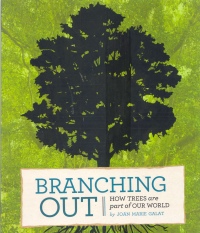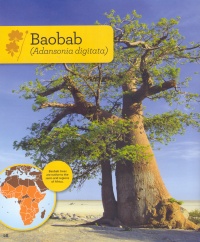| ________________
CM . . .
. Volume XXI Number 12. . . .November 21, 2014
excerpt:
This nonfiction guide to trees is a beautiful book for readers ages 10 to 12 years. Organized by type of tree, it provides general information on different trees from around the world and includes fascinating details on how humans and animals depend on each tree. While the overall content is good, the text meanders a bit, and sometimes has trouble getting to the point. This is particularly apparent in the introduction.
Other features are less than exemplary examples. Each tree is compared in size to a two story house, but this element is in a small circle slightly larger than a golf ball, making each tree look exactly the same size. Text is squeezed onto the page and would have benefited from larger margins, particularly given the publisher’s target audience starting at age eight. Perplexingly, the book does not make use of bold words which would help younger readers with such dense text. There is a glossary, but words in the text are not marked as included. This design decision hinders the effectiveness of the book. For example, the word ‘ecosystem’ is defined in a photo caption on a page with the heading ‘Why You Need Trees’. With small margins, small comparison boxes and no bold words, the text could be a bit overwhelming for younger readers. Despite these challenges, the information is good and was vetted by a professor of forestry at UBC. Joan Marie Galat has wisely chosen examples of how humans use trees that will appeal to youth while still conveying the importance of each tree to the local ecosystem. Young readers who enjoy nonfiction and have an interest in environmental issues will enjoy this book. Both public and school libraries will find it a useful addition to their collections. Recommended. Sophia Hunter is a teacher librarian at Crofton House Junior School in Vancouver, BC.
To comment
on this title or this review, send mail to cm@umanitoba.ca.
Copyright © the Manitoba Library Association. Reproduction for personal
use is permitted only if this copyright notice is maintained. Any
other reproduction is prohibited without permission.
Next Review |
Table of Contents for This Issue
- November 21, 2014. |

 Branching Out has mixed success with its use of nonfiction features. Each tree gets a full page picture which helps readers clearly see the distinctions between each tree. Useful maps show where in the world each tree can be found. Fact boxes enhance the text nicely. There are great close up shots of important details, such as the bark or small critters that depend on the tree to live. These elements are all well done.
Branching Out has mixed success with its use of nonfiction features. Each tree gets a full page picture which helps readers clearly see the distinctions between each tree. Useful maps show where in the world each tree can be found. Fact boxes enhance the text nicely. There are great close up shots of important details, such as the bark or small critters that depend on the tree to live. These elements are all well done.